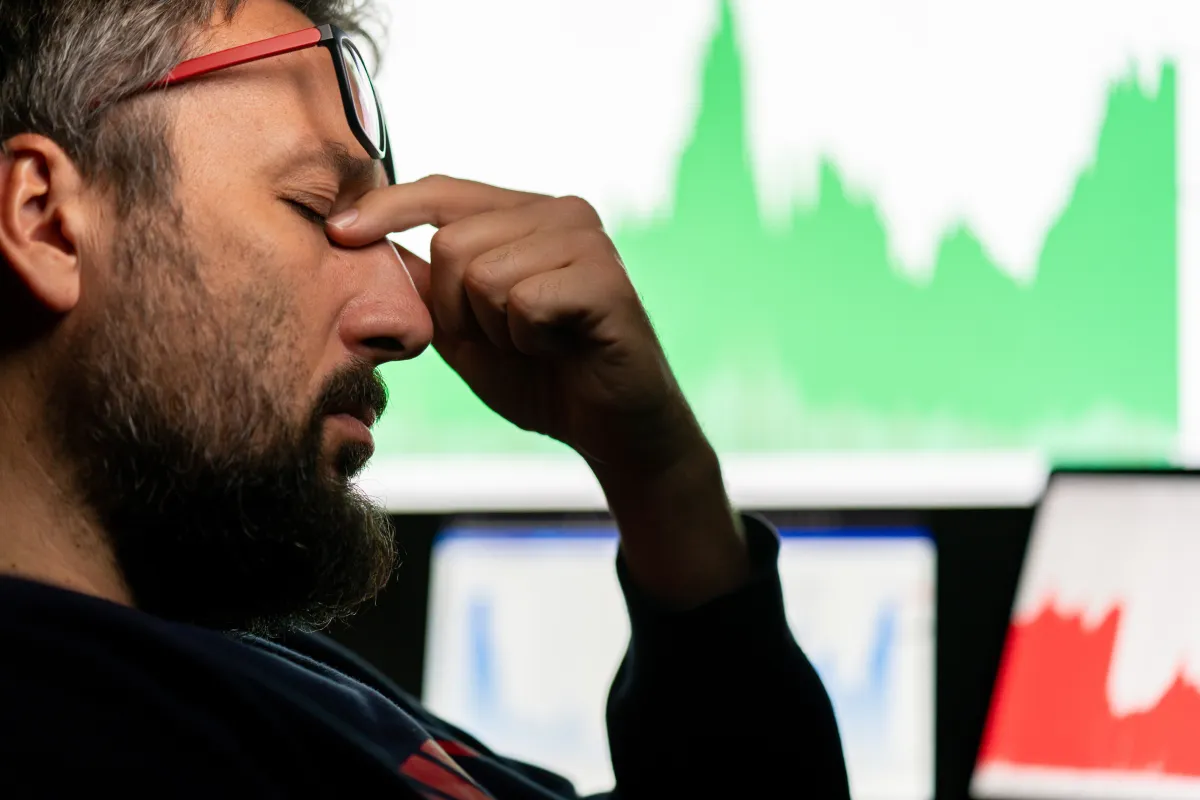Ready to see the market clearly?
Sign up now and make smarter trades today
Trading Basics
August 6, 2025
SHARE
Why You Keep Getting Stopped Out—and What the Pros Do Instead
Feeling the market has a personal grudge against your stop loss? Maybe it probably just knows where you hid it! Getting stopped out just before the move happens is one of the most frustrating parts of trading.
So, are you a trader using tight stops in futures, crypto, or stocks? Read this article to learn why this happens and, more importantly, how professional traders avoid it. Also, you’ll understand how to improve your trading stop loss strategy and the real reasons pros don’t get picked off so easily!
Additionally, from confirmation tactics to smart risk placement, we’ll cover how pros use stop losses with intent, not emotion. Stop being an exit liquidity! Read till the end to think, plan, and trade like the other side of the screen.
Why You’re Getting Stopped Out
Getting stopped out again and again can feel like the market is hunting your position! But are you:
- Using tight stop losses
and
- Chasing breakouts without confirmation?
If it’s a yes, you might be falling into common traps that professionals exploit. Let’s understand in detail:
1. Stops at Obvious Levels
Most retail traders, particularly those using a trading stop loss strategy, place stops at predictable spots. Check out the graphic below to learn what these predictable spots are:
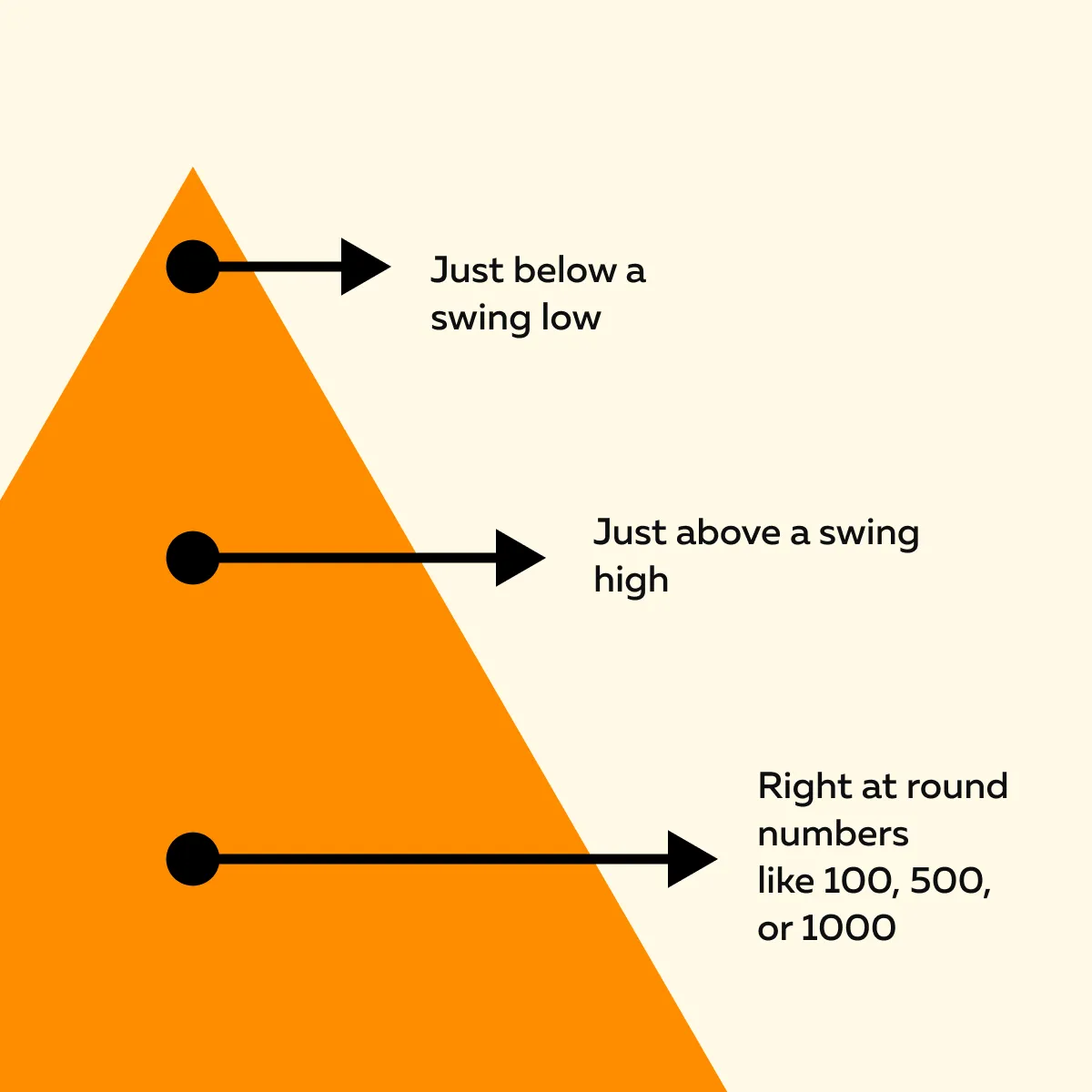
These areas are like flashing signs saying, “Here’s where my stop is!” The ill effect? – They act as prime zones for “stop hunting.” It is a popular term used when bigger players, like institutions or market makers, intentionally push the price into those levels to trigger your stop loss. Why? Because your stop equals liquidity. They need that liquidity to enter or exit large positions.
For example:
- You’re trading crypto or futures.
- You see a breakout above yesterday’s high and jump in.
- Your stop? Just under that range! It seems safe to you.
- But what happens?
- The price quickly dips down.
- Then, the price hits your stop.
- Later, the price rockets higher.
- That’s a classic case of stop hunting.
So, if you’re asking, “Why do I keep getting stopped out?” This is often the first and most painful reason. Pros know where the crowd hides their stops! They use that information to gain better entries.
2. No Confirmation Before Entry

One big reason why you keep getting stopped out is entering a trade without any confirmation. You must realize that just because the price touches a level, like a previous high, a support zone, or a trendline, doesn’t mean it will bounce or reverse from there.
In contrast, most professional traders don’t blindly jump in! They wait for signs that the level is holding. The three major signs they observe are:
| Sign I | Sign II | Sign III |
|
|
|
This is a part of how pros use stop losses! Please note that the pros enter only when there’s intent. This gives their stop a reason to exist and not just a price level to sit under.
How to Spot These Signs?
By using our advanced real-time market analysis tool, Bookmap, you can spot this confirmation. Let’s see what you can do with our modern market analysis tool, Bookmap:
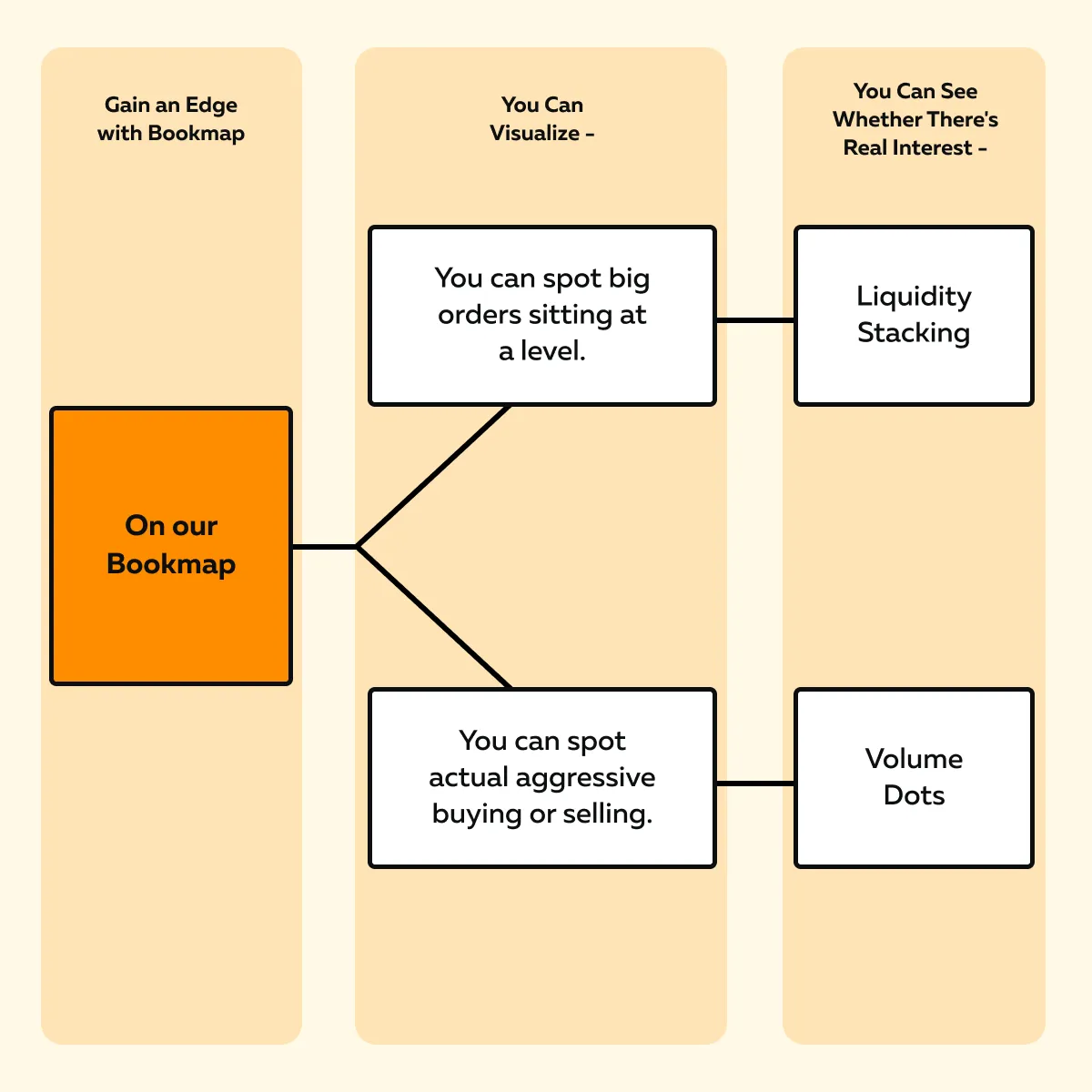
Without this kind of confirmation, you’re basically guessing! And when you guess, your stop loss becomes an easy target.
3. Chasing Moves in Thin Liquidity
Ever felt like you entered just as the move ended? That’s because you’re chasing! When you chase a breakout, particularly in futures, crypto, or fast-moving stocks, you’re often the last one in. This usually happens in thin liquidity zones, where there are very few resting buy/ sell orders.
In such areas, even a small push can cause major price fluctuations. This happens due to a lack of resistance. Such a fluctuation is highly risky because:
| Volatility spikes | Slippage | Fakeouts |
|
|
|
So, these breakouts often fail because they’re not supported by strong market interest, and your stop can get hit easily if you jump in without confirmation.
4. Using Stops as a Crutch
Many retail traders, particularly those still refining their trading stop loss strategy, use stops as a safety blanket. They feel, “I’ll just put a stop here because it feels safe.” But feelings aren’t strategy!
Most pros don’t use stops for emotional comfort. They use them to say, “If the price gets to this level, my idea is invalid.” That’s how pros use stop losses! They define risk based on the setup, not personal fear!
So, are you placing stops just beneath every entry without logic? If yes, you are trading blindfolded. This habit makes you a perfect target for stop hunting!
What Professional Traders Do Differently
If you’ve been frustrated asking, “Why do I keep getting stopped out?” It’s time to understand how professional traders think. Please note that pros don’t rely on hope or tight lines. Instead, they rely on:
- Structure,
- Patience, and
- Smart execution.
Let’s understand how they approach the game differently:
1. Think in Zones, Not Lines!
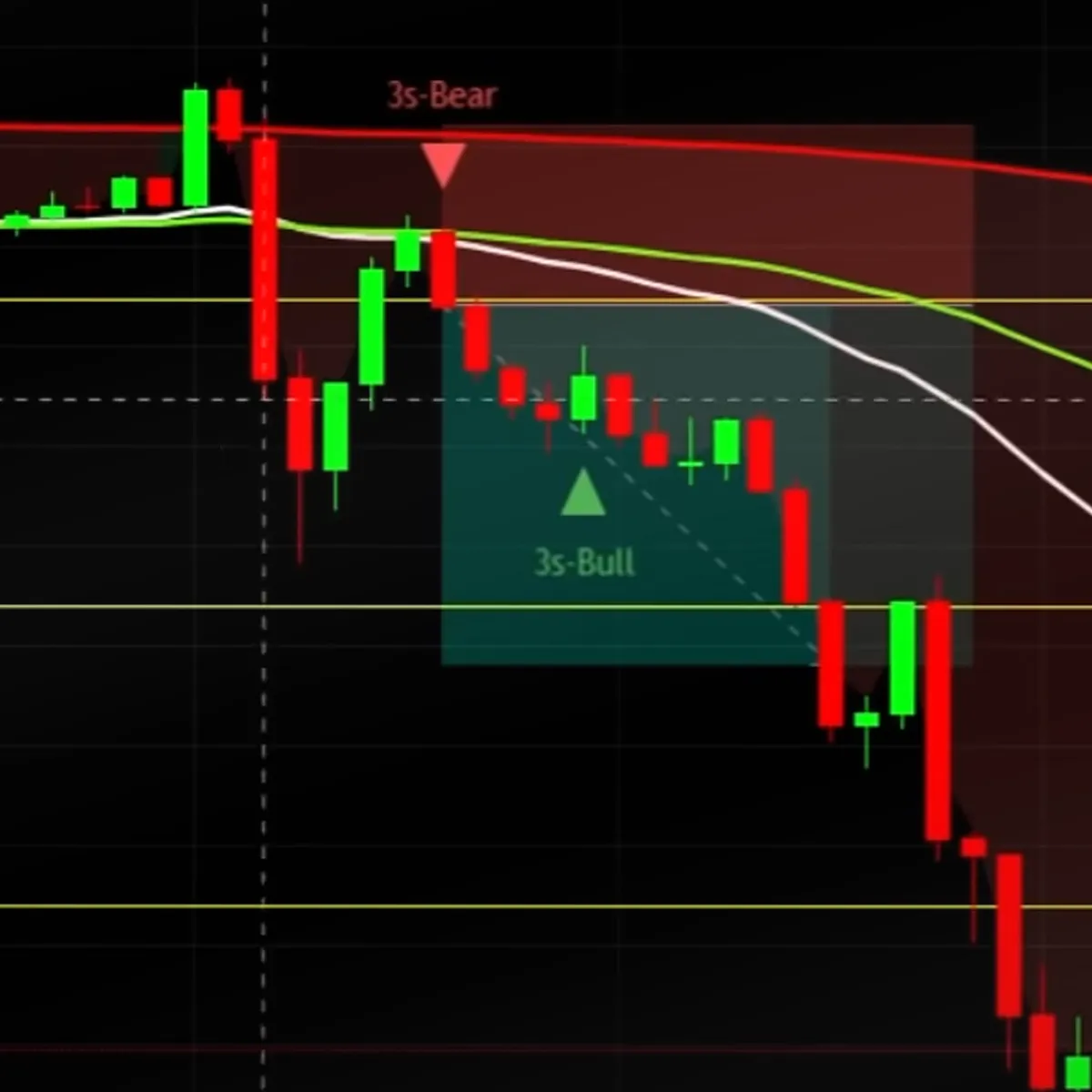
One of the biggest differences is that pros don’t treat levels like “exact price points.” They think in zones, not precise lines. For example:
- A pro does not put a stop exactly at a swing low.
- Instead, they place it a bit beyond the area where most retail stops are clustered.
Why? Because they know that the price doesn’t turn on a dime. It probes! The price always wicks through highs and lows to trigger stops before reversing. That’s classic stop hunting behavior. That’s why most pros place their stops outside that “danger zone,” where the price shouldn’t go if their trade idea is right.
You must observe that in this smart trading stop loss strategy, you define your risk based on where your setup breaks down and not where it feels “safe.”
Still getting stopped out by surprise moves? See how real-time order flow shows you the traps before they spring. → Compare Plans
2. Wait for Trap Behavior or Confirmation
Pros don’t guess! They watch others guess. And when they get it wrong, the pros act. Most veteran traders look for signs that the crowd is trapped. Check out the graphic below to learn about these signs:
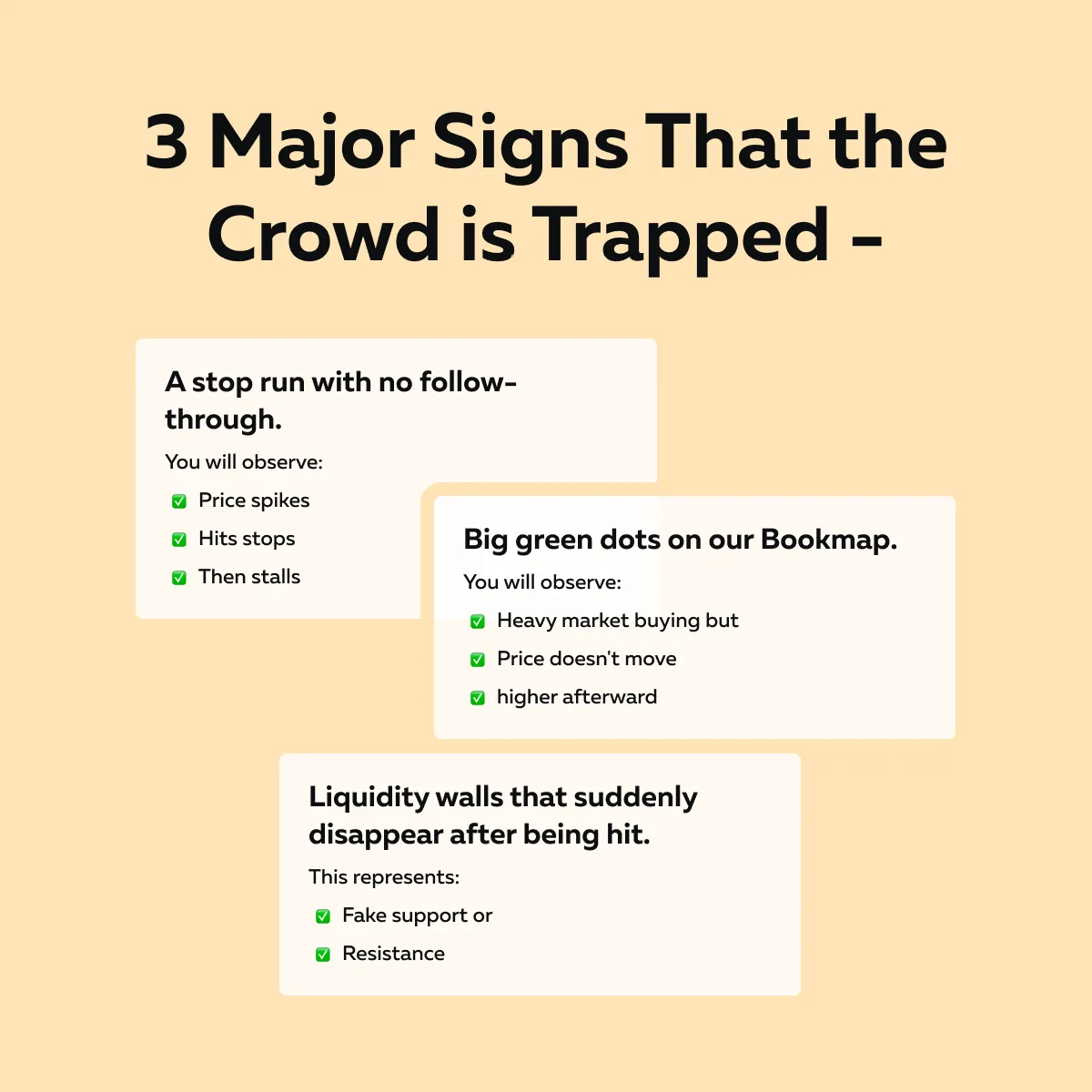
These are signals of trap behavior. Most pros love to trade against it! So, this is how pros use stop losses:
- They enter where others are panicking
and
- They avoid zones where everyone is piling in.
By waiting for confirmation or signs of crowd error, they increase their odds and reduce noise-based stop-outs. That’s the difference between trading smart and trading emotionally!
3. Use Manual Stops or Mental Exits
Another reason pros don’t get stopped out as often is that they avoid broadcasting their stops. Please note that in futures, crypto, and even stocks, stop orders sit in the order book. As a result, most smart algorithms can see them. This makes you vulnerable to stop hunting!
Therefore, professional traders often use manual stops or mental exits instead. That means:
- They place a wider stop loss far from the current price.
- Such a placement protects them against disaster moves.
- But they “exit manually” when their trade idea is proven wrong, like when key support breaks or volume dies.
By doing so, they’re not hiding behind stops! Instead, they’re actively managing risk based on what the market is showing them.
4. Build Around Areas of Control
Professional traders don’t chase price! They build positions in places where they feel in control. Now, what does that mean? Most pros wait for the following three areas:
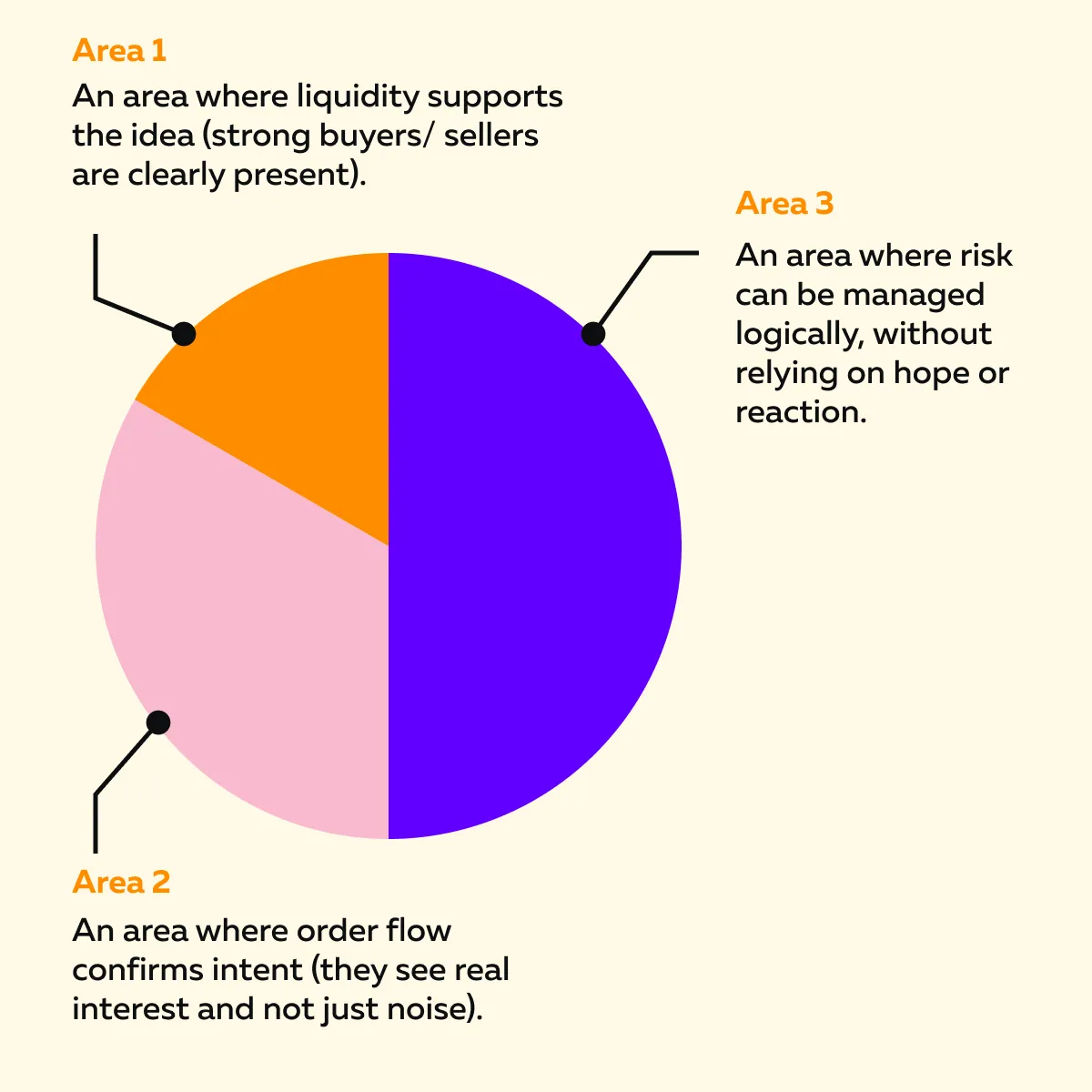
This is a smart trading stop loss strategy! In it, you’re:
- Not reacting to price
but
- Planning around structure.
However, be aware that following this strategy requires you to “wait,” sometimes much longer than most retail traders are willing to.
A Better Way to Think About Stop Placement
Your question: “Why do I keep getting stopped out?”
The solution: Change how you think about stop placement.
It is never about moving your stop loss further! The best traders don’t treat stops as afterthoughts. They make them part of the plan, which is based on the following:
- Logic,
- Structure, and
- Behavior.
Let’s understand how you can level up your approach:
Your Stop Is Your “I Was Wrong” Line
Your stop loss should answer one question: “What would prove this trade idea wrong?”
Too many retail traders set stops based on:
- The percentage they’re willing to lose
or
- The Number that feels safe.
But that’s not how pros do it. Instead, they define a specific price zone that, if reached, invalidates the setup. That’s where their stop goes!
Please realize your stop isn’t just a damage control tool. Instead, it’s a logical part of your trade thesis. If that level breaks:
- You admit: “Okay, I was wrong,”
and
- Exit with discipline.
Tight stops and guesswork don’t cut it. Use the same tools large players use to manage entries and exits. → Compare Plans
Use Structure + Behavior Together
Placing a stop just under support or above resistance isn’t enough! You need to combine technical structure with real-time market behavior. Let’s see why:
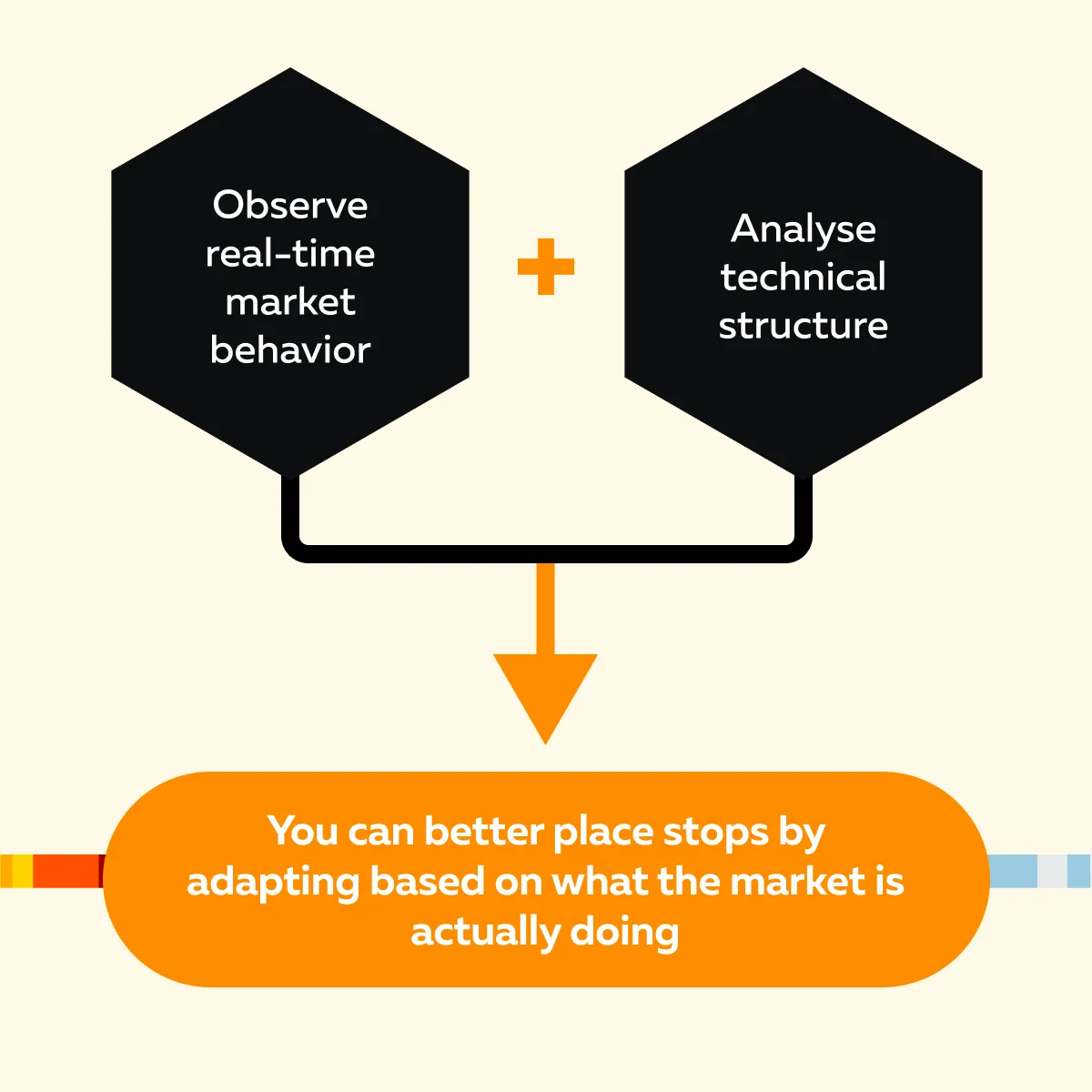
In this layered approach of stop placement, you should:
| First watch: | Then observe: |
|
|
This layered approach gives you more confidence! Through it, you can exit even before your stop is hit. Even most pros follow this approach and avoid falling into obvious stop hunting traps. They don’t just place stops where they “should.” They adapt based on what the market is actually doing!
3. Know When Not to Trade
Sometimes, the best stop loss is no trade at all. You should not trade when:
- You can’t define your risk clearly
or
- You don’t have a strong reason for your stop,
If you still do, you’re not trading; you’re donating! In fact, you may just be the liquidity that smarter traders are waiting to use.
Do you know what the pros do?
-
- They use stop losses with discipline.
- They only place risk in zones where they feel in control.
- If the setup is unclear or sloppy, they simply skip it.
- No FOMO and no revenge trades!
So next time you’re unsure where to put your stop, ask yourself: “Do I understand this setup well enough to risk money on it?” If the answer is no, the right move might be – no trade at all.
Conclusion
Getting stopped out over and over doesn’t mean you’re a bad trader. Instead, it means you might be entering without enough context or confirmation. Most retail traders fall into the same traps. They often place stop losses at obvious levels that smart money can easily target, chase price moves out of fear of missing out, and make decisions driven by emotion rather than logic or a clear plan.
Meanwhile, professional traders lose too! But their losses are part of a plan. Their stop losses are placed with intent, not “guesswork.” Most of them think in zones, wait for confirmation, and act only when the trade is in their control.
So, does your stop keep getting hit at the worst possible place? It’s not just bad luck! It’s a signal to change your approach. You must learn to read the market’s clues. Additionally, don’t be the liquidity pros who are hunting. Start thinking like them! Stop chasing breakouts blindly. Learn to read where the real support is. → Compare Plans
FAQ
1. Why do I always get stopped out before the move happens?
This usually happens because your stop loss is placed in a very obvious spot, such as:
- Just under a recent low
or
- Just above a recent high.
Most big players know retail traders put stops there! Thus, they push prices to those levels to trigger them.
Now, if you enter without waiting for signs like rejection or confirmation, you’re often entering too early. That makes your stop easy to hit before the real move begins.
2. How do pros avoid stop-outs?
Professional traders avoid unnecessary stop-outs by being patient. They don’t enter just because the price hits a level. Instead, they look for signs that the market is showing real interest, such as:
- Strong buying or selling that holds
or
- Other traders are getting trapped in the wrong direction.
After watching for these signs, they place their stop where the setup would truly fail. Mostly, they avoid zones where prices might pull back for a moment. This approach makes their risk more strategic.
3. Should I use a wider stop loss?
Not always! A wider stop doesn’t automatically make a trade better. What matters is placing your stop where your trade idea would be proven wrong.
Now, sometimes that means using a tighter stop if the setup is strong and clear. Whereas, other times, it means giving the trade more space. You do this when the market is choppy.
Please understand that the key is to base your stop on structure and logic, not on fear or hope.
4. Can I see stop hunts in real time?
Yes, but you need the right tools! By using our avant-garde real-time market analysis tool, Bookmap, you see hidden things like:
- Sudden volume spikes,
- Fake breakouts, and
- Big traders absorbing orders.
These signs often appear before a stop hunt happens. By reading this data, you can avoid placing stops in risky areas. Moreover, you can even trade in the opposite direction once the trap is set. Please realize that it is about watching the clues and not guessing.
